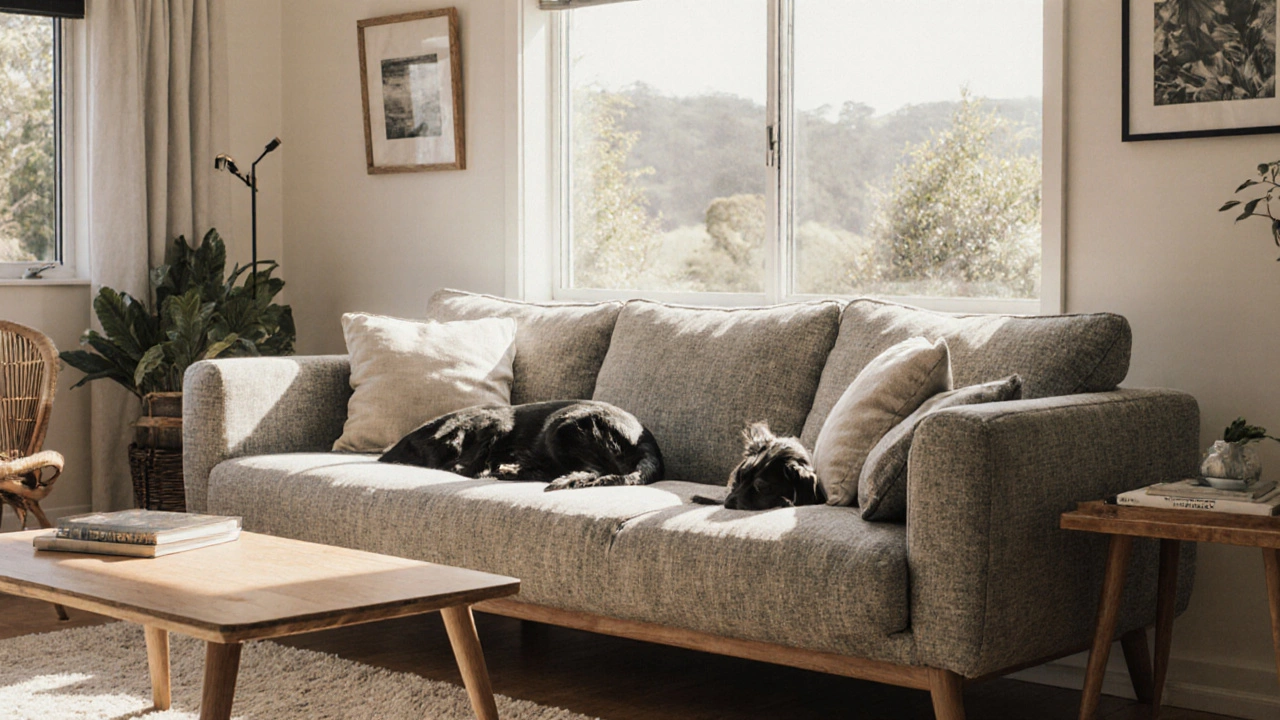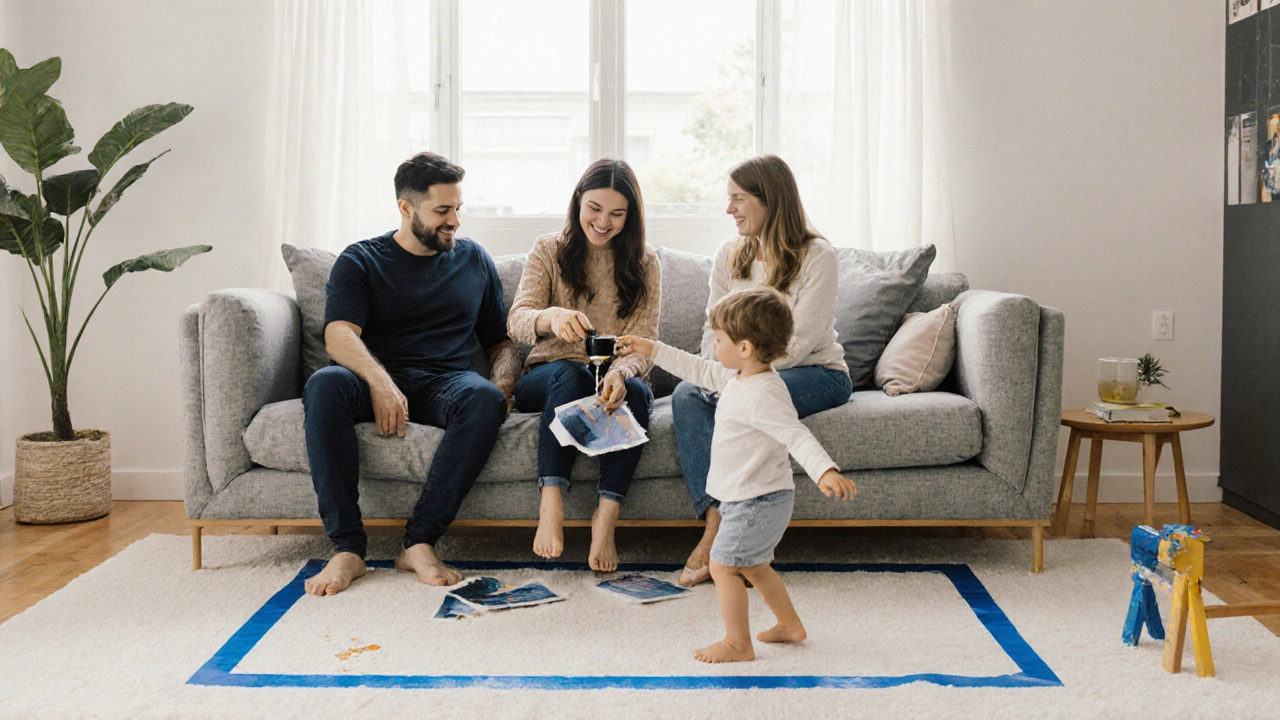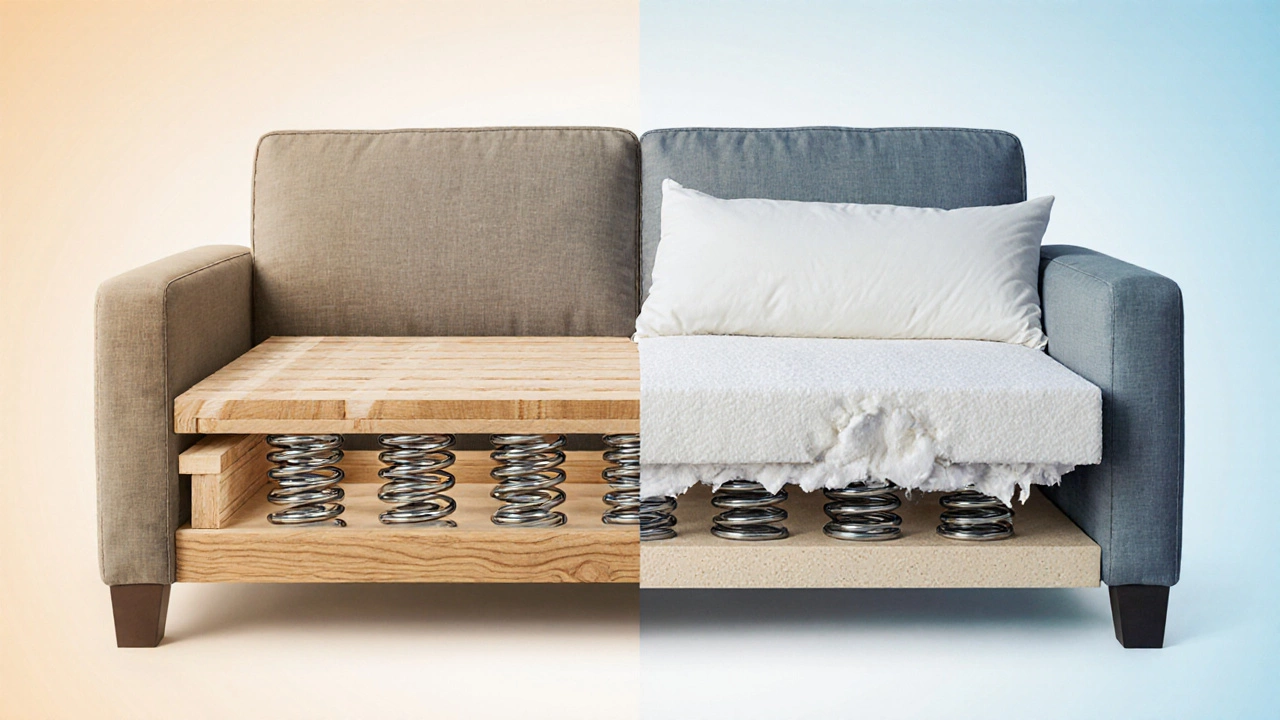How Much Money to Spend on a Couch: Real Prices for Lasting Comfort
 Oct, 29 2025
Oct, 29 2025
Couch Value Calculator
Calculate Your Couch's True Cost
How much does your couch really cost per year? Find out by entering the price and expected lifespan.
Your couch costs per year.
Compared to a $300 couch that lasts 2 years ($150/year), this one costs per year.
Key Insight:
The article explains that a $300 couch that falls apart in 2 years costs $150/year, while a $1,200 couch lasting 10 years costs $120/year.
Most people buy a couch once every 5 to 10 years. That means when you do buy one, you want to get it right. Not just because it’s expensive, but because it’s the one piece of furniture you sit on every single day. You eat on it. You watch movies on it. You nap on it. You argue on it. So how much should you actually spend? The answer isn’t a number. It’s a balance between what you can afford, what you need, and what will last.
Don’t Just Look at the Price Tag
A $300 couch from a big-box store might look tempting. But if it sags after six months, you’re not saving money-you’re just paying twice. A $1,200 couch that lasts 10 years costs $120 a year. A $300 couch that falls apart in two years? That’s $150 a year. And you’re stuck with a pile of foam and broken wood in your garage.
Real quality shows up in the frame, the springs, and the fabric. Hardwood frames-like kiln-dried oak or maple-are the gold standard. Avoid particleboard or plywood. You can’t see it, but you’ll feel it. Sit on the couch and twist your body. If it creaks or flexes too much, the frame is weak. That’s not a deal. That’s a warning.
Spring systems matter too. Eight-way hand-tied springs are the best. They’re expensive, but they hold their shape for decades. If you see sinuous springs (S-shaped wires), that’s fine for mid-range sofas. But if the springs feel loose or you can feel them through the cushion, walk away.
What’s the Real Range in New Zealand?
In Auckland, you’ll find couches from $500 to $5,000. But most people end up spending between $1,200 and $2,500 for something that actually works. Here’s how it breaks down:
- $500-$900: Basic foam cushions, particleboard frame, synthetic fabric. Good for rentals, student flats, or temporary use. Won’t last beyond 3 years.
- $1,000-$1,800: Solid wood frame, sinuous springs, medium-density foam. This is the sweet spot for most families. Brands like Freedom, Harvey Norman, and local makers like Studio 8 a New Zealand-based furniture maker known for handcrafted, durable sofas using local timber and eco-friendly fabrics offer solid value here.
- $1,900-$3,000: High-density foam or down blend cushions, hardwood frame, eight-way hand-tied springs, premium fabrics like linen or top-grain leather. These are built to last 10-15 years. Look at local artisans like House of Haze a Wellington-based studio crafting custom sofas with sustainable materials and modular designs or imported European brands like BoConcept.
- $3,000+: Custom-made, designer pieces. Hand-stitched details, exotic woods, luxury fabrics. You’re paying for craftsmanship, not just comfort. These are heirlooms.
If you’re buying new, aim for the $1,200-$1,800 range. You get the best mix of durability, comfort, and value. If you’re on a tighter budget, don’t skip the frame. A $800 couch with a solid wood frame will outlast a $1,200 one with particleboard.
Fabric Matters More Than You Think
You spend hours picking a colour. But fabric is the real test. Here’s what actually works in a New Zealand home:
- Performance fabrics: Brands like Crypton or Sunbrella repel spills, resist stains, and hold up to pets and kids. They’re worth the extra $200-$400. You’ll thank yourself when your toddler spills tomato soup or your dog sheds everywhere.
- Linen: Beautiful, breathable, natural. But it wrinkles, fades in sunlight, and shows dirt. Only choose this if you’re willing to vacuum weekly and keep curtains closed during the day.
- Leather: Real leather lasts longer than fabric, gets better with age, and is easy to wipe clean. But it’s cold in winter, hot in summer, and scratches easily. Avoid bonded or faux leather-they peel after two years.
- Microfiber: Affordable, durable, and soft. Often the best choice for families. Look for a density rating of 30,000+ rubs (Martindale test). Anything under 15,000 won’t survive.
Ask for a fabric swatch. Take it home. Rub it with your keys. Spill coffee on it. See how it reacts. Don’t trust the salesperson’s word. Test it yourself.

Size and Layout Are Non-Negotiable
Nothing kills a couch faster than being the wrong size. A too-big couch makes your living room feel cramped. A too-small one looks lost. Measure your space before you even look at prices.
Use painter’s tape on the floor to mark out the dimensions. Sit in the space. Walk around it. Make sure you can open doors, move past it, and still have room for a coffee table. Most Auckland apartments have narrow hallways and staircases. A couch that’s 220cm long might not even fit through your front door. Always check delivery access.
Sectionals are great for large spaces, but avoid them if you’re in a small flat. A simple two-seater or three-seater with a matching ottoman gives you flexibility. You can rearrange it, move it, or even use the ottoman as a footrest or extra seat.
Buy Used? Here’s How to Do It Right
Secondhand couches can save you 50-70%. But only if you know what to look for.
- Check the frame. Lift the couch. If it’s light, it’s probably particleboard. Solid wood feels heavy and dense.
- Push down on the cushions. Do they spring back? Or do they stay flat? Foam that doesn’t rebound is dead.
- Look under the cushions. Are the springs tight? Are there any stains or odours? Smoke, mildew, or pet smells are permanent.
- Ask for the original receipt or brand name. Google it. See what the original price was. If it was $2,500 new and you’re paying $400, that’s a steal.
- Buy from private sellers, not junk shops. Facebook Marketplace, Trade Me, and local Facebook groups are better than thrift stores.
Reupholstering is an option if the frame is good. A professional reupholster in Auckland charges $800-$1,500 to redo a three-seater. That’s still cheaper than a new high-end couch-and you get to pick the fabric.

What You Should Never Compromise On
There are three things you should never cut corners on:
- The frame: It’s the skeleton. If it’s weak, nothing else matters.
- The cushion fill: High-density foam (35kg/m³ or higher) or a down-blend with a foam core. Avoid cheap foam-it turns to mush in months.
- The warranty: Look for at least a 5-year warranty on the frame and springs. If they won’t offer one, they don’t believe in their own product.
Ignore the extras. Nailhead trim, tufting, or decorative pillows? They’re decoration. They don’t make the couch better. Focus on the inside.
Final Rule: Spend What You Can, But Never Less Than $800
If you’re on a tight budget, save up. Don’t buy a $400 couch just because it’s on sale. That’s a trap. A $800 couch with a solid frame and good fabric will serve you better than a $300 one. And if you can stretch to $1,500, you’re setting yourself up for a decade of comfort.
Think of it this way: a couch is like a mattress. You spend a third of your life on it. Would you buy a $200 mattress? No. So why buy a $300 couch?
Buy once. Buy well. Your back, your guests, and your future self will thank you.
Is it worth spending more than $2,000 on a couch?
Only if you plan to keep it for 15+ years or want custom design features. Most people don’t need a $3,000 couch. But if you have the space, the budget, and you love the craftsmanship-yes. High-end sofas use solid hardwood frames, hand-tied springs, and top-grain leather that improves with age. They’re built to be passed down.
Can I find a good couch under $1,000?
Yes, but only if you’re okay with compromises. Look for solid wood frames (not particleboard), high-density foam cushions (35kg/m³ or more), and performance fabric. Brands like Freedom’s Essentials line or local makers on Trade Me often hit this mark. Avoid anything with thin cushions or flimsy arms.
Should I buy a sectional or a regular sofa?
Sectionals are great for large open-plan living rooms and families who use the couch as a daily lounge space. But in smaller Auckland apartments, they can make the room feel smaller and harder to navigate. A three-seater with a matching ottoman gives you the same flexibility without the bulk. You can move it, reconfigure it, or even use the ottoman as a footrest or extra seat.
How long should a couch last?
A well-made couch lasts 10 to 15 years. Cheaper ones last 3 to 5. The key is the frame and cushion fill. If the frame is solid hardwood and the cushions are high-density foam or down-blend, it will hold up. If it’s particleboard and low-density foam, it’ll sag and creak by year three. Always check the warranty-5 years or more means the maker stands by it.
Is leather better than fabric for a couch?
Leather lasts longer and is easier to clean, but it’s not always better. Real leather gets cold in winter and can crack if exposed to direct sunlight. It also shows scratches. Fabric is more forgiving and comes in more colours and textures. Performance fabrics like Crypton are stain-resistant and durable-perfect for families. Choose leather if you want timeless style and easy maintenance. Choose fabric if you want comfort, variety, and warmth.
What’s the best way to test a couch before buying?
Sit on it like you live there. Lean back, cross your legs, stretch out. Push down on the arms and back. Wiggle side to side. Does it creak? Does the frame flex? Lift the cushions-do you feel springs or just foam? Ask for a fabric swatch and test it with water, your keys, and your fingernail. If it stains or tears easily, walk away. And always check delivery access-many couches can’t fit through narrow hallways or staircases.
If you’re still unsure, wait. Don’t rush. A couch is one of the biggest purchases you’ll make for your home. It’s not just furniture-it’s where you rest, connect, and unwind. Get it right the first time.